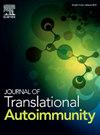Across ancestries, HLA-B∗08:01∼DRB1∗03:01 (DR3) and HLA-DQA∗01:02 (DR2) increase the risk to develop juvenile-onset systemic lupus erythematosus through low complement C4 levels
IF 3.6
Q2 IMMUNOLOGY
引用次数: 0
Abstract
Objective
Systemic lupus erythematosus (SLE) is a systemic autoimmune/inflammatory disease with a strong genetic component. Genetic burden is higher in children when compared to patients with adult-onset SLE, contributing to earlier disease expression and more severe phenotypes. The human leukocyte antigen (HLA) cluster on chromosome 6p21.3 is among the most variable genomic regions, representing a major risk-factor for SLE in adults. Its impact on juvenile-onset (j)SLE remains largely unstudied.
Methods
High-resolution sequencing of HLA class I (A, B, C), class II (DRB1, DQA1, DQB1) and class III (complement C2) was undertaken in the multi-ancestral UK JSLE Cohort including participants of Caucasian (n = 151, 48.8 %), Asian (n = 108, 35.0 %) and African/Caribbean (n = 50, 16.2 %) descent. Considering ancestral variation, clinical associations were tested at the level of alleles (2-field resolution), associated HLA protein sequences (antigen binding domains, 4-field resolution), and extended haplotypes (DRh).
Results
Although important ancestral recombination was reported for HLA-DR2 and -DR3 haplotypes, risk associated with jSLE was conserved at related alleles (DR2h: DRB1∗15:01, DQA∗01:02, DQB1∗06:02; DR3h: C∗07:02 [Asian], B∗08:01, C2 rs9332730 [Asian], DRB1∗03:01). HLA-DR7 haplotypes (DRB1∗07:01, OR = 0.44, 95 % CI:0.27–0.72, p = 0.0004; DQA1∗02:01, OR = 0.34, 95 % CI:0.21–0.56, p = 1.8 × 10−6) protect Asians from jSLE development. Among 23 clinical variables recorded, the main association was found between low levels of complement C4 in Caucasian carriers of HLA-DR3h. This was not the case in Asians due to recombination with HLA-C∗07:02 and integration of the C2 rs9332730 minor allele. Low C4 serum levels associated with HLA-DQA1∗01:02 (DR2h) in Caucasians after excluding HLA-DR3h carriers from the analysis. An association between low white blood cell counts and HLA-A∗03:01P was observed across ancestries.
Conclusion
Genetic variation in the HLA cluster associates with organ domain involvement (hematological) and complement levels in jSLE. Lupus-associated HLA haplotypes vary between ancestral groups, underscoring the importance of multi-ancestral approaches to genetic studies in SLE and other autoimmune/inflammatory diseases.
在整个祖先中,HLA-B∗08:01 ~ DRB1∗03:01 (DR3)和HLA-DQA∗01:02 (DR2)通过低补体C4水平增加了发生青少年性系统性红斑狼疮的风险。
目的:系统性红斑狼疮(SLE)是一种具有强烈遗传成分的系统性自身免疫/炎症性疾病。与成人发病的SLE患者相比,儿童的遗传负担更高,导致疾病表达更早,表型更严重。6p21.3染色体上的人类白细胞抗原(HLA)簇是最可变的基因组区域之一,是成人SLE的主要危险因素。它对青少年发病SLE (j)的影响在很大程度上尚未研究。方法:在多祖先英国JSLE队列中进行HLA I类(A, B, C), II类(DRB1, DQA1, DQB1)和III类(补体C2)的高分辨率测序,包括高加索(n = 151, 48.8%),亚洲(n = 108, 35.0%)和非洲/加勒比(n = 50, 16.2%)血统的参与者。考虑到祖先变异,在等位基因(2场分辨率)、相关HLA蛋白序列(抗原结合域,4场分辨率)和扩展单倍型(DRh)水平上检测临床相关性。结果:尽管报道了HLA-DR2和-DR3单倍型的重要祖先重组,但与jSLE相关的风险在相关等位基因上是保守的(DR2h: DRB1∗15:01,DQA∗01:02,DQB1∗06:02;DR3h: C∗07:02 [Asian], B∗08:01,C2 rs9332730 [Asian], DRB1∗03:01HLA-DR7单倍型(DRB1 * 07:01, OR = 0.44, 95% CI:0.27 ~ 0.72, p = 0.0004;DQA1∗02:01,OR = 0.34, 95% CI:0.21-0.56, p = 1.8 × 10-6)保护亚洲人免受jSLE的发展。在记录的23个临床变量中,发现主要与HLA-DR3h白人携带者补体C4水平低有关。亚洲人的情况并非如此,这是由于与HLA-C * 07:02的重组和C2 rs9332730小等位基因的整合。排除HLA-DR3h携带者后,白种人血清低C4水平与HLA-DQA1 * 01:02 (DR2h)相关。低白细胞计数和HLA-A∗03:01P之间的关联在不同的祖先中被观察到。结论:HLA集群的遗传变异与jSLE的器官受累(血液学)和补体水平有关。狼疮相关HLA单倍型在不同的祖先群体之间存在差异,这强调了多祖先方法在狼疮和其他自身免疫性/炎症性疾病遗传研究中的重要性。
本文章由计算机程序翻译,如有差异,请以英文原文为准。
求助全文
约1分钟内获得全文
求助全文
来源期刊

Journal of Translational Autoimmunity
Medicine-Immunology and Allergy
CiteScore
7.80
自引率
2.60%
发文量
33
审稿时长
55 days
 求助内容:
求助内容: 应助结果提醒方式:
应助结果提醒方式:


